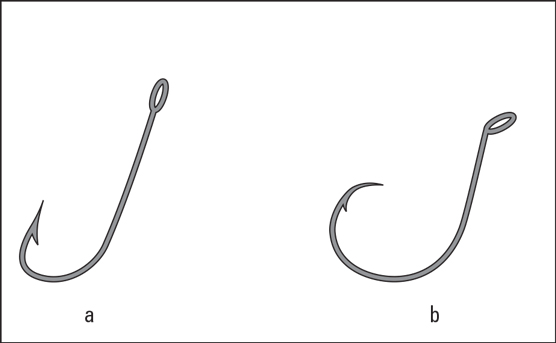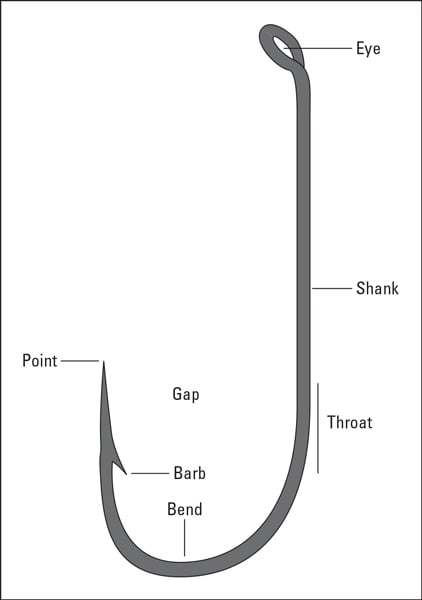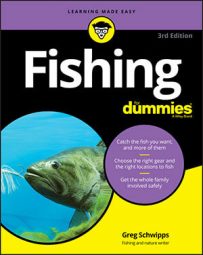The first hook-type devices, called gorges, were used during the Stone Age. Gorges were small pieces of wood or bone sharpened on both ends, with a line tied to the center. When embedded in bait, the entire gorge could be swallowed by a fish, and when the line jerked tight, the gorge would lodge across the throat of the fish.
Later, the traditional fish hook was carved from bone. The invention of metal made for better fish hooks, and after centuries of progress, today’s hooks are sometimes chemically sharpened and surgical in their effectiveness. But the basic shape of the hook remains the same.
Both J hooks and circle hooks are shown in the following figure. Circle hooks have been used for decades in saltwater fishing but are now being used in more freshwater fishing. Circle hooks look like joke hooks — you might swear one could never hook a fish. But they work, and because they rotate around a fish’s jaw, caught fish are often hooked in the corner of the mouth, making them easy to release. Most of the following information about J hooks applies to circle hooks, but the two kinds of hooks require very different hooksets.
 The standard J hook (a) and circle hook (b).
The standard J hook (a) and circle hook (b).
Following are the most important parts of a typical hook:
-
The point is where tackle meets fish. As in many situations in life, the first impression is an important one. If you don’t have a good sharp point on your hook, you can have the most expensive rod in the world, but you won’t catch anything but weeds.
-
The barb is a type of a reverse point that is designed to keep a fish on the hook after the fish bites. Bigger is not better with barbs. Big barbs can make setting a hook difficult when the hook meets up with a tough-mouthed fish like a bonefish. Or big barbs can make too big a tear in the mouth of a soft-mouthed fish like a crappie. Many catch-and-release anglers fish with barbless hooks, although it is possible to release fish caught on barbed hooks, as well.
-
One way to help speed up the releasing process when you’re fishing catch-and-release is to debarb your hooks. Simply take a pair of pliers (needlenose work best) and crimp the barb against the hook’s tip.
-
The bend is the curved part of the hook, and all those fine-sounding hook names, such as Limerick or Sproat, have something to do with the bend. Actually, such hook names have to do with two parts of the bend: the throat and the gap.
-
Think of the throat as the depth that the hook penetrates.
-
Think of the gap as the width of the hook, from point to shank. A relatively wide gap may be necessary to hold certain bait, to get around the snout of a billed fish, or to dig in beyond the width of a thick jawbone.
The wider the gap, the easier it is for the fish to bend the hook so that it can escape. When the hook straightens out, your hook is either too light (referring to the gauge of the wire) or too big in the gap for the amount of pressure that you (not the fish) applied.
-
-
The shank connects the bend to the eye. A shank can be long or short. As with gap, a longer shank means that a hook is easier for a fish to bend. So why aren’t all hooks short-shanked? The answer has to do with what goes on the hook: different-sized bait needs different-sized shanks to keep it held on securely. A longer-shanked hook makes it easier to unhook a fish, too.
Sometimes the shank has a barb or two to help hold bait more securely. These are called baitholder hooks.
-
The eye of the hook (the loop through which line passes) may be turned up, turned down, or straight.
-
The gauge refers to the diameter of the hook’s wire. Heavier gauge hooks resist bending even when imbedded in the mouth of a big fish. Smaller gauge hooks are lighter and easier to hide.
-
The finish refers to the coating on the hook. Some hooks wear a finish to protect them from saltwater; others are finished in bright colors. It adds to the options you have in selecting hooks.
 The anatomy of a hook.
The anatomy of a hook.J hooks: Some things never change
J hooks earned their name from their resemblance to the letter. J hooks work because they fit into a fish’s mouth and then catch on something on the way out, and they’ve worked that same way for a long time. Not every J hook is the same, though, and many styles put a twist (sometimes quite literally) on the standard. Any fish that swims can be caught on the right J hook.Buy J hooks that match your intended target. What’s the typical mouth size of the fish you hope to catch? Bluegills, for example, have small mouths; even a big specimen would have to open wide to bite the tip of your thumb. So, using giant J hooks to fish for bluegill will only result in hooks stripped of bait. But a fish with a big, toothy mouth, like a northern pike, calls for a larger J hook.
Setting the hook with J hooks
When a fish bites a baited hook or lure, you’ve been successful: You’ve seduced that fish into making a connection with you. But that connection — through the rod and reel, down the line, across any terminal tackle your rig consists of, and culminating in the sharp hook you’ve selected — is a tenuous one. You need to act quickly and wisely to ensure that the fish stays connected to you. This is called setting the hook, and it’s the process by which the hook passes from merely being in the fish’s mouth to being through the fish’s mouth. When fishing with J hooks, setting the hook means pointing the rod at the fish, tightening the line, and jerking the rod sharply up toward you, driving the hook into the fish’s mouth.Different species call for different hooksets, and different baits call for different tactics. For example, it pays to let northern pike run a big livebait for a bit, to allow the pike time to turn the baitfish in its mouth. Largemouth bass striking at a plastic frog through a layer of algae need a bit of time to get the frog bait into their mouths. Some fish have hard mouths that require hard and repeated hooksets. Others, like crappies, will go free if you set the hook too hard. But the following tips should work for you most of the time, with most fish caught on most rigs:
- Keep a relatively tight line between your hook and your reel at all times. When fishing with a float rig, for example, slack line can form between your rod and the float. When a fish bites and the float sinks, that fish is ready to be hooked, but the slack line can prevent you from driving the hook home. By the time you furiously crank up the loose line, the fish may have spit the bait and moved away. Keep your line tight, and be ready to set the hook at any time.
- Let the rod help you. As you sweep the rod overhead, the rod should bend. This bend is providing the force that sets the hook. If your rod isn’t bending on the hookset, you’re not providing enough force. The other possibility is that there remains too much slack in the line. If that happens, quickly reel up the slack and set the hook again. The fish may still be on the line!
- Quicker hooksets are usually better. I don’t usually advise waiting to set the hook, unless it’s one of those odd situations, like catching bass through the moss. Look at it this way — if you feel a fish tap your bait, or your float goes under, that fish has your hook in its mouth. If the bait is in a fish’s mouth, then the hook should be able to find purchase. Some folks will tell you to wait, to “make sure he has it” or something, but most of the time this pause results in a swallowed hook. A swallowed hook can lead to an inadvertent fish death, and is usually the result of waiting too long to set the hook. Your goal should be to land every fish that bites, but also to be able to release every fish you land, should you choose to do so.
Keeping J hooks organized
As I explain in the earlier section “Keeping a range of hooks,” you really can’t avoid accumulating more than a few styles and sizes of hooks. Having a good variety of J hooks on hand will find you ready for about any fishing challenge. But although you may lump all your plastic worms together or carry a sack of assorted sinkers, you should keep your hooks divided.Separate your hooks in your tackle carrier by placing different sizes in different compartments. Plastic lidded trays like those from Plano and Flambeau are perfect for this, and some are made of materials that resist the formation of rust on your hooks. Sort by size and function. Put small baitholders (ideal for bluegill) and the like in one place, larger hooks for rigging soft plastics Texas-style in another. Hooks have a nasty habit of tangling together when stored in proximity, making it harder to remove the hook you need when you need it. Picking a tiny hook from a snarl of hooks is like reaching into a bag of needles.
Circle hooks: From saltwater to freshwater
Circle hooks are sized like J hooks, and available in the same wide range. Because they are so often used in saltwater, circle hooks for species like groupers and sharks could almost encircle a coffee cup. But manufacturers make small circle hooks too, and they work for many freshwater species. (And they are increasingly available anywhere freshwater gear is sold.) I use small circle hooks — about a size 6 — to catch carp. And 8/0 circle hooks, which work well for a variety of saltwater species, are perfect for blue catfish. The design of the circle hook would appear to render it impotent — with the point of the hook aimed back toward the shank, how could it possibly catch fish? Well, therein lies its beauty. Circle hooks are less likely to snag, and that includes your person, simply because the point of the hook is not exposed. But they will catch fish, providing the angler can forget everything he or she knows about setting the hook in the traditional J hook fashion.Setting the hook with circle hooks
Anglers fishing with J hooks should strike fast and hard to set the hook. Indeed, a wimpy hookset could lead to a freed fish. But circle hooks work differently than J hooks, and they require a different method.Circle hooks work because fish often move after they pick up a bait or lure. Say a smallmouth bass grabs a nightcrawler rigged on a circle hook. The smallmouth will inhale the nightcrawler and then most likely turn away from the place where it sucked in the bait. The nightcrawler — and the hook — will be in the bass’s mouth for a second or two before it swallows. As the bass turns, the hook drags across the mouth of the fish, lodging in the corner of the jaw. As the bass continues to move, the hook rotates until the gap of the hook fits around the jaw. Then the point sinks in and the bass is hooked.
I know it sounds unlikely. I didn’t believe it at first either. Now that I have caught hundreds of fish using circle hooks, I rarely buy J hooks. Circle hooks work that well.
Here’s the secret — you cannot set the hook in the traditional J hook fashion using circle hooks. If you do, you will simply jerk the baited hook right out of the fish’s mouth. Instead, you need to maintain constant line pressure, and let the fish hook itself against the steady pull. A hookset with a circle hook looks like this — the angler feels the tap, then slowly raises his or her rod and holds it in a raised position. The fish will pull the rod down, and the action of the rod will drive the hook point into the fish’s jaw. When the angler feels the fish has been hooked — often when the rod bends as much as it would with a J hook hookset — he or she simply commences reeling in the fish. Anglers used to fishing with J hooks will have a maddening time trying to retrain themselves, but they can do it. (At first, they’re likely to instinctively jerk the hook out of the fish’s mouth!) But beginners, who have never learned the hard hooksets of J hooks, will take right to it.
Using rod holders for circle hooks
A great way to learn how to use circle hooks is to go stillfishing for almost any species and bring along some rod holders. Rod holders, often steel or heavy plastic, do just that — they hold the rod for you. For bank fishermen, rod holders are often designed to be driven into the ground or sand. (Surfcasters use them, too.) Some are made to attach to piers or fishing docks. There are many rod holders designed to be used with a variety of boats.All rod holders work the same: They hold the rod securely, allowing the angler to fish multiple rods, or to put some distance between himself and the rod (say, so he can sit by the fire and eat fried chicken). Whereas rod holders work with all kinds of fishing gear, they are ideally suited for bank fishing with spinning, spincast, or baitcasting gear. And they work perfectly when paired with circle hooks.
When using rod holders, the angler doesn’t have to fight the urge to set the hook. Simply cast the bait out, and place the rod in the holder. Keep the line fairly tight. When a fish strikes, the rod pulls down, or loads, against the weight of the fish. (It’s important to have strong rod holders, mounted securely, or you risk losing your gear!) When the rod is sufficiently loaded, the rod is removed from the holder, and the fish is already hooked and ready for battle.
Kids, beginners, and elderly anglers may have trouble setting the hook with sufficient force. This kind of stillfishing — using rod holders and circle hooks — removes the need to “cross the fish’s eyes” with a rocking hookset. And the enjoyment of fighting the fish is the same.
Experiment with circle hooks, and I think you’ll find that most caught fish are hooked in the corner of the mouth, ready for an easy release. I also think you’ll find that fish hooked with circle hooks have a difficult time throwing the hook during the fight. When the circle hook finds its place, the fish is quite simply . . . hooked.
